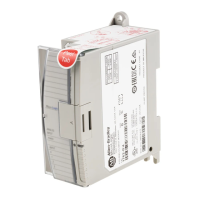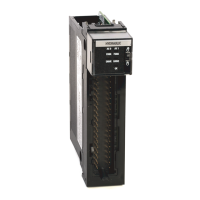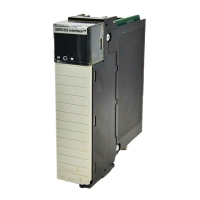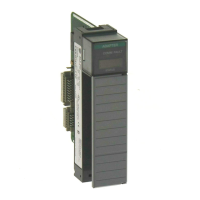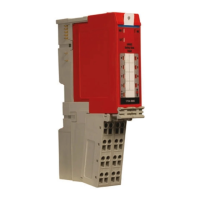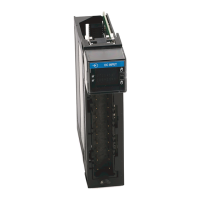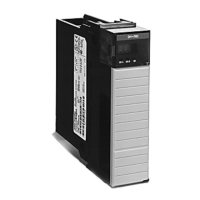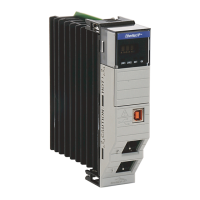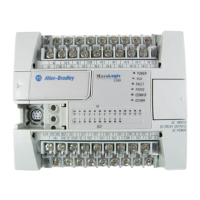
Do you have a question about the Allen-Bradley MicroLogix 1200 and is the answer not in the manual?
| Series | MicroLogix 1200 |
|---|---|
| Type | Programmable Logic Controller (PLC) |
| Mounting | DIN rail or panel mount |
| Programming Language | Ladder Logic |
| Programming Software | RSLogix 500 |
| I/O Points | Up to 40 |
| Communication Ports | RS-232, RS-485 |
| Memory | 6 KB user memory |
| Power Supply | 24V DC or 120/240V AC |
| Expansion | Supports expansion I/O modules |
| Operating Temperature | 0°C to 55°C (32°F to 131°F) |
| Dimensions | 90 mm x 110 mm |
| Weight | 0.5 kg (1.1 lbs) |
Identifies the target audience for the manual, including designers, installers, and programmers.
Provides a reference guide for MicroLogix 1200 controllers and expansion I/O, detailing installation and wiring procedures.
Lists additional documents containing information on Rockwell Automation products for deeper understanding.
Explains conventions used in the manual, such as bulleted lists, numbered lists, and italic type for emphasis.
Details the physical components and features of the MicroLogix 1200 controller.
Provides descriptions of key components like the memory module and real-time clock.
Describes the 1762 series expansion I/O modules and their connection to the controller.
Lists compatible communication cables for connecting the MicroLogix 1200 controllers.
Explains the software and methods used for programming the MicroLogix 1200 controller.
Details the evolution of controller firmware, including new features added in each revision.
Outlines the various communication protocols and network options available for the controller.
Lists the safety and regulatory certifications applicable to the controller.
Provides guidelines and factors to consider for proper controller installation in industrial environments.
Highlights critical safety practices and precautions for controller installation and operation.
Explains the function and importance of the Master Control Relay for emergency shutdown.
Details the procedures and considerations for physically mounting the controller unit.
Describes the steps and requirements for mounting the controller onto a standard DIN rail.
Provides instructions for mounting the controller securely onto a panel using screws.
Explains how to connect expansion I/O modules to the controller unit.
Specifies the necessary wire types, sizes, and installation guidelines for controller wiring.
Offers best practices for routing wires and maintaining separation for optimal performance.
Explains the importance and methods for using surge suppressors to protect output contacts.
Details the procedures for proper controller grounding to mitigate noise and ensure safety.
Provides visual representations of how to wire controller and expansion I/O modules.
Illustrates the layout and grouping of terminals on the controller for wiring connections.
Explains how DC inputs can be configured as sinking or sourcing, with corresponding diagrams.
Provides guidelines and methods for wiring analog modules, including system wiring considerations.
Lists the communication protocols supported by the controller via its RS-232 channel.
Describes the default communication settings for Channel 0 and the Programmer/HMI Port.
Explains how to use the toggle push button to manage communication configurations.
Details methods for connecting the controller to a personal computer via the RS-232 port.
Describes how to establish a DF1 point-to-point connection between the controller and a PC.
Explains how modems can be used to connect PCs to controllers for communication.
Provides instructions for connecting the controller to a DF1 Half-Duplex network.
Details how to connect the controller to a DH-485 network, including recommended tools.
Explains how to connect and use the AIC+ for network communication and isolation.
Describes how to connect the controller to a DeviceNet network using the DNI.
Explains the function of the controller's trimming potentiometers for data modification.
Details the composition of the Trim Pot Information (TPI) Function File.
Describes potential error conditions related to the Trim Pot Information Function File.
Covers the operation, installation, and removal of the Real-Time Clock module.
Explains the status of the RTC battery, its lifespan, and implications for data retention.
Details the features and functions of the memory module for program storage and backup.
Describes how the memory module facilitates simple and flexible program/data transport.
Explains how the memory module can provide application security by comparing programs.
Provides detailed electrical, environmental, and performance specifications for the controllers.
Lists the technical specifications for the various 1762 series expansion I/O modules.
Details the common and general specifications for analog I/O modules.
Lists replacement kits available for the MicroLogix 1200, including terminal blocks.
Details replacement parts for the 1762 Expansion I/O, such as doors, latches, and labels.
Explains the meaning of controller status LEDs for diagnosing operational states.
Provides a systematic approach to diagnosing and recovering from controller software and hardware issues.
Covers troubleshooting procedures for analog expansion I/O modules, including diagnostics.
Guides users on what information to have ready when contacting technical support.
Outlines the necessary steps to prepare the controller and PC before upgrading the operating system.
Details the procedure for installing the ControlFlash software required for OS upgrades.
Describes the key events and steps involved in the operating system upgrade process.
Identifies the LED pattern indicating a failed or corrupted operating system download.
Explains the RS-232 interface standard and its characteristics for serial communication.
Describes the DF1 Full-Duplex protocol for point-to-point connections and its benefits.
Details the DF1 Half-Duplex protocol for multi-drop networks and its master/slave capabilities.
Explains the use of dial-up, leased-line, and radio modems for controller communication.
Defines the DH-485 protocol for multi-device communication over a single pair of wires.
Lists other Allen-Bradley devices that support the DH-485 network.
Provides factors to consider for planning a robust DH-485 network configuration.
Shows network diagrams illustrating how to connect MicroLogix controllers to the DH-485 network.
Describes the Modbus protocol for master-slave communication and its use with MicroLogix 1200.
Explains ASCII communication for connecting to devices like barcode readers and serial printers.
Explains how to calculate and validate system load to avoid exceeding power supply capacity.
Provides an example calculation for system loading validation for 24-point controllers.
Provides an example calculation for system loading validation for 40-point controllers.
Details how to determine the heat dissipation of the system for enclosure installation.
